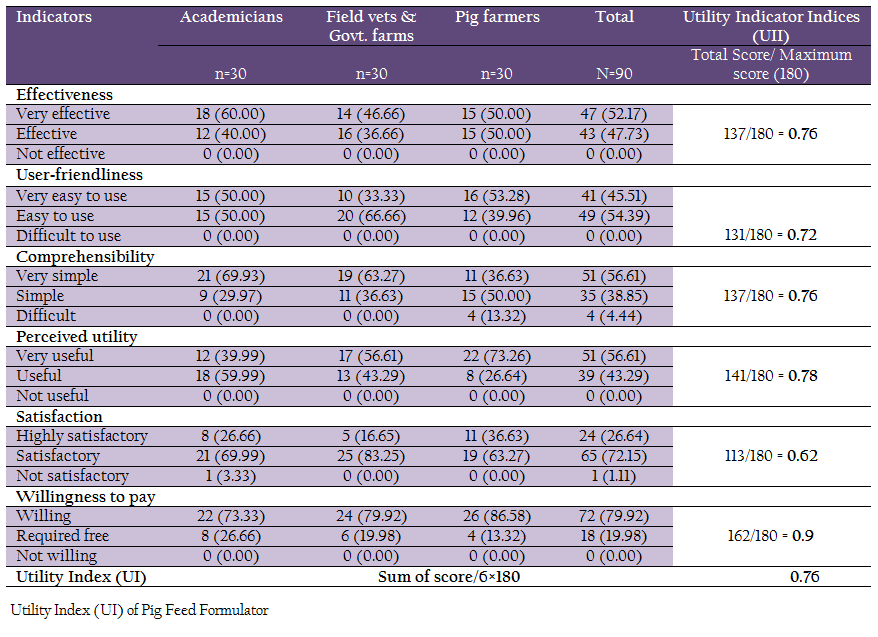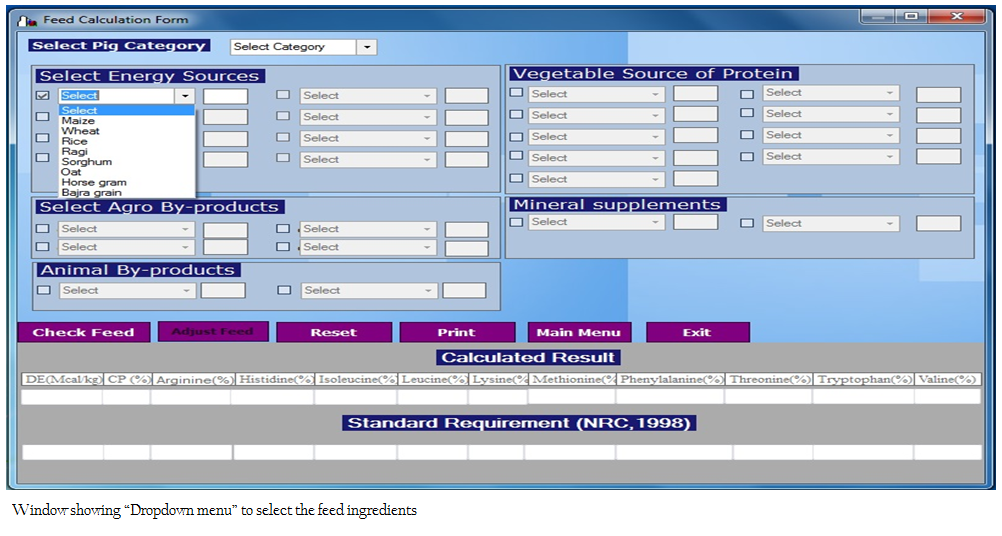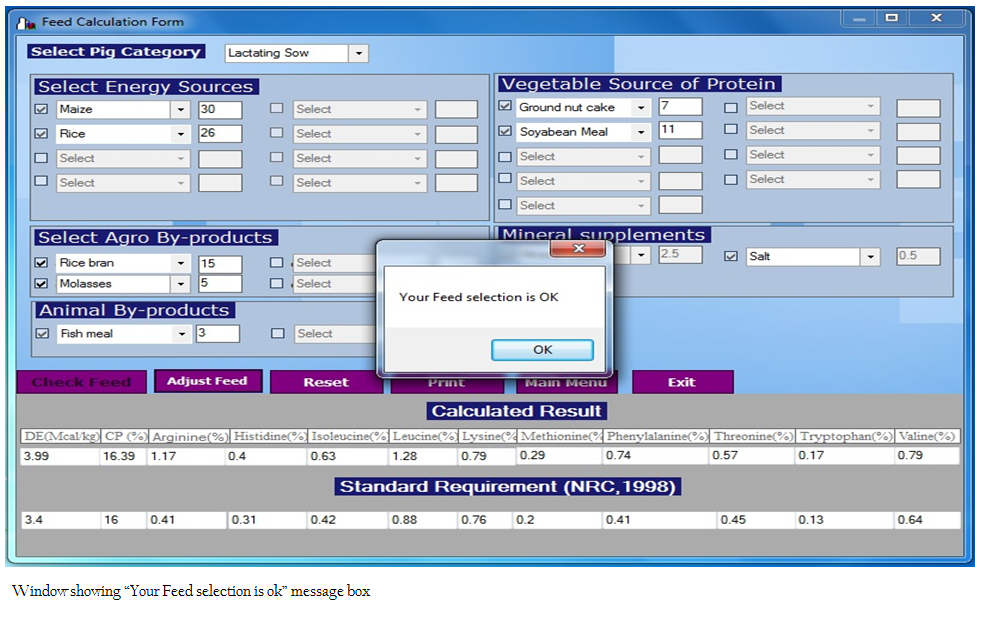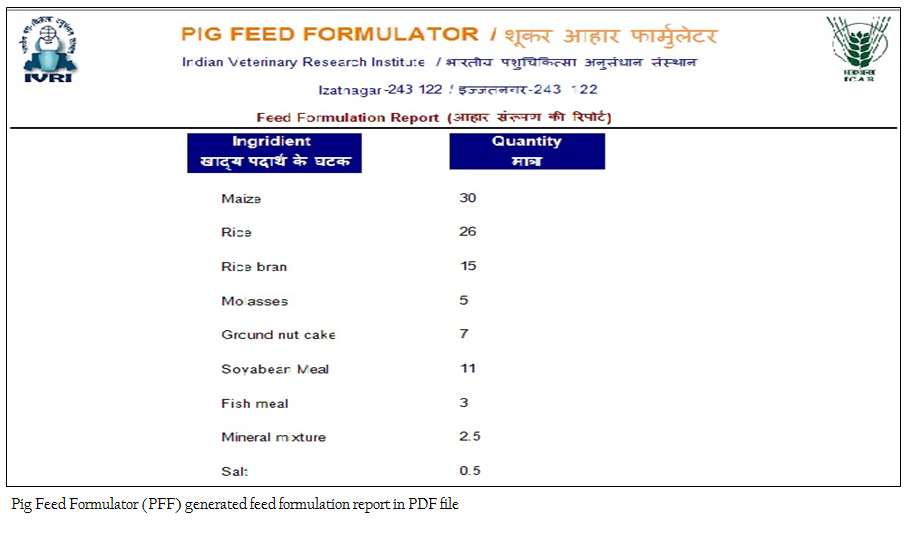Advances in Animal and Veterinary Sciences
Research Article
Advances in Animal and Veterinary Sciences 2 (5): 264 – 269Pig Feed Formulator (PFF): A Need Based Feed Formulation Software for Commercial Pig Farmers of India
Dileep Kumar Hanume Gowda1*, Rupasi Tiwari1, Yash Pal Singh1
- Division of Extension Education, Indian Veterinary Research Institute Izatnagar, 243122 (U.P.), India
- Joint Directorate Extension, Indian Veterinary Research Institute Izatnagar, 243122 (U.P.), India
- ARIS Cell, Indian Veterinary Research Institute Izatnagar, 243122 (U.P.)
*Corresponding author: dilext4933@yahoo.co.in
ARTICLE CITATION:
Gowda DKH, Tiwari R, Singh YP, (2014). Pig feed formulator (PFF): A need based feed formulation software for commercial pig farmers of India. Adv. Anim. Vet. Sci. 2 (5): 264 – 269.
Received: 2014–04–03, Revised: 2014–04–22, Accepted: 2014–04–23
The electronic version of this article is the complete one and can be found online at
(
http://dx.doi.org/10.14737/journal.aavs/2014/2.5.264.269
)
which permits unrestricted use, distribution, and reproduction in any medium, provided the original work is properly cited
ABSTRACT
Pig production in India have come a long way from traditional open grazing-based pig production to concentrate feed based commercial production in certain pockets of India. There has been limited information about feeding system, production performance, needs and constraints of these farms due to their scattered spatial distribution. The present study was designed to study these issues and develop a need based pig feed formulation software. A sample of 100 commercial pig farmers across five states of India was interviewed to assess the needs and performance of commercial pig farms. Based on the need, software called “Pig Feed Formulator (PFF)” was developed to assist the pig farmers in on-farm feed formulation using locally available feed ingredients. PFF was administered among 90 respondents including academicians, field veterinarians and commercial pig farmers (30 respondents from each group) in two states to assess the perceived utility of PFF. The study revealed that majority of commercial pig farmers were not aware of balanced feeding despite 83% of literacy. Average body weight of fatteners at 6 months and litter size was found to be 37% and 29.72% less than the attainable production. Even with good digital literacy most of the commercial pig farmers were not aware of feed formulation software but, majority of them were interested to use it. Post development assessment showed that utility index of the software was found to be very high (UI = 0.76) with maximum willingness to pay (UII = 0.9). The average price quoted on PFF was rupees 1,188.
INTRODUCTION
The spurts in the economic growth, increased per capita income over the decades have diversified food habits of the people in India from staple foods towards protein rich foods like meat and dairy products. Projected per-capita demand for meat in India is 11.8 kg in 2015 and 17.9 kg in 2030 (Keyzer M.A. et al., 2005). The total pork requirement of India is around 0.88 million tonnes (NRC on Pig, vision 2030) against this; the country produces only 0.32 million tonnes (FAOSTAT, 2012). Thus the present shortfall is 0.56 million tonnes or 63.63%. These factors have led to the shift from open grazing-based pig production to concentrate feed based commercial production in many parts of the country. Due to low genetic merit and improper feeding average meat yield of pigs in India is only 35 kg / animal, which is about 55% less than corresponding value of the world average (FAOSTAT, 2012). Over 35% of the world’s cereals are fed to livestock (Trostle, 2008), whereas in India, ≤ 10% of the coarse grains produced (40.5 million tonnes) in the country is used for livestock feeding. Total availability of concentrate feed ingredients for livestock feeding was estimated to be about 23 million tonnes and the requirement is 53 million tonnes (NABCONS, 2007). The deficiency of more than 60% of the concentrated feed resource in the country is a major threat to the pork industry (NRC on Pig, vision 2030). This calls for the efficient and judicious use of the available feed resources in commercial piggery. In the context of inadequate extension staff, improper feeding and poor production; need for an information and communication technology (ICT) tool which can overcome all the above mentioned constraints was strongly felt and so the idea of development of need based feed formulation software was conceived.
Many feed-formulation software like FeedSmart (Dobos and Fulkerson, 2004), InraPorc (Van Milgen et al., 2008), Winfeed (www.winfeed.com), Feedsoft (www.feedsoft.com), MakeFeed (Nath. et al., 2002) etc. are commercially available. But, for farmers these software packages are expensive (Thomson and Nolan, 2001) and are developed mainly for commercial dairy and poultry production. Some developed for pig feeding, abroad are very sophisticated and are intended for factory farming. Therefore, need for the software at the farmers’ level was assessed and software called “Pig Feed Formulator (PFF)” was developed to assist the pig farmers in on-farm feed formulation using locally available feed ingredients.
MATERIALS AND METHODS
Assessment of need for feed formulation software
The present study was conducted in purposively selected five states of India viz. Uttar Pradesh, Punjab, Jharkhand, Chhattisgarh and Karnataka to represent northern, western, eastern, central and southern part of India respectively. Study was conducted in two districts of each state (Rampur and Bareilly district of Uttar Pradesh, Mysore and Mandya district of Karnataka, Ranchi and Latehar district of Jharkhand and Durg and Bilaspur district of Chhattisgarh). A sample of 10 farmers from each district was selected thus, forming a total sample size of 100 commercial pig farmers (having herd size of ≥ 50 pigs) to assess the need.
To assess the need for the feed formulation software, the study focused on the farmer’s awareness, willingness to know about scientific feeding of pigs, feeding pattern and body weight of fatteners at 6 months of age in their farms. Computer possession, awareness about feed formulation software, Interest to use feed formulation software and digital literacy of pig farmers was also studied to assess the capabilities of the farmers to use feed formulation software. Data was collected through personal interview method using a pretested interview schedule. A need based feed formulation software called “Pig Feed Formulator (PFF)” was then developed based on the need. Development and assessment of “Pig Feed Formulator (PFF)” PFF has been developed by using an integrated development environment (IDE) from Microsoft called Visual Studio 2010 for front end (user interface) and the database management system (DBMS), Microsoft SQL server 2008 R2 has been used to design the back end. The programming language used to develop PFF was C #. It is windows - based user friendly software, compatible with windows vista with service pack 2, windows - 7 and it’s above version. The necessary scientific data for the development of the database of the software have been collected consulting authenticated scientific literature. Nutrient requirement of pigs and classification of pig is adopted from Nutrient requirements of Swine (NRC, 1998).
PFF employs trial and error method of ration formulation and is powered to handle 25 feed ingredients including mineral mixture, common salt and vitamin mix which are commonly available in the most parts of the country. End-user can have choices from the list of feed ingredients provided in the ingredient list under 5 sub -heads viz. energy source, agro by-products, vegetable source of protein, animal by-products and minerals and vitamin supplements based on the availability and preferences. It can balance 10 essential amino acids beside crude protein and digestible energy (Mcal / kg feed) in the final feed formulation. Based on their opinion and recommendations of experts, inclusion level of certain feed ingredients have been restricted to recommended limits due to toxic principles and the adverse effect they cause on pigs health upon excess feeding. A unique feature of the software is that, it has tutorial video (In Hindi and English) with the audio backup to help the beginners showing, “how to formulate balanced feed”. The Programme was developed in two languages, Hindi and English (official languages of India). The PFF was tested for its perceived utility among commercial pig farmers (30), field veterinarians (30) and academicians (30) from 2 states viz. Uttar Pradesh and Karnataka, thus forming a total sample size of 90 respondents. The overall utility of the software was quantified by Utility Index (UI), which was measured by 6 indicators (effectiveness, user-friendliness, comprehensibility, perceived utility and willingness to pay). The collected data was subjected to analysis using suitable statistical tools such as frequency, percentage and chi-square test.

Table 3: Distribution of respondents according to Body weight of fatteners at 6 months of age (in Kg)
RESULTS AND DISCUSSION
Feeding and production performance in commercial pig farms The study revealed that 87% (Table: 1) of the respondents were not aware of the scientific feeding of pigs despite 83% of them being literates.
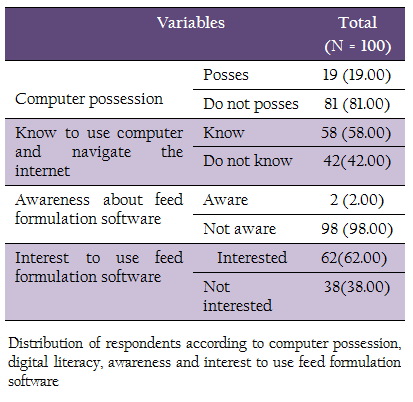
Table 4: Distribution of respondents according to computer possession, digital literacy, awareness and interest to use feed formulation software
The poor awareness was well reflected in the fact that, about 28% of farmers were feeding exclusively swill feed and 42% of them were supplementing swill with little grains like broken rice maize and cakes. Only 22% of the farmers were supplementing feed with some protein sources (cakes) otherwise rest were feeding only energy source. Mineral mixture was fed by only 40% of the farmers. The pattern of feeding was not found to be significantly (p < 0.05) different among the farms (classified bases on herd size) (Table: 2). Average litter size and average body weight of fatteners at 6 month of age was found to be 7.73 and 37.79kg (Table: 3) respectively. Poor knowledge about feeding (Deka et al., 2007., Tiwari and Tiwari., 2001 and Verma et.al., 2007), improper feeding, poor management practices and lower average daily weight (Kumaresan et. al., 2007) were also reported to be some of the major constraints to improve pig production. All the pig farms considered under the study were operated commercially with 100% stall feeding. This kind of production system demands adequate knowledge and management skills for the economic viability of the farm. Since feed accounts for the 70-75% of the production cost; knowledge about scientific feeding is of paramount importance in commercial pig production. But majority of the pig farmers were not aware of scientific feeding of pigs. Average litter size of 10 -12 and average body weight of 60 kg at 6 months for fatteners (Hand book of animal husbandry, 2011) can be achieved in Indian conditions. But, these production parameters were found to be 29.72% and 37% less than the attainable production. It was interesting that 79.00 % (Table: 1) of the farmers were willing to know about scientific feeding.
Assessment of digital literacy of the commercial pig farmers
It was found that, about 58.00% of the respondents had skills to use computer and navigate the internet but only 19.00% of them had personal computer. Even though the level of digital literacy was appreciable, only 2.00% of the farmers were aware of feed formulation software. However, 62.00% (Table: 4) of them showed interest to use; once they were informed about the utility of such software. Regarding the language of the software; 63% of the respondents preferred Hindi followed by regional language (29.00%) and English language (11.00%). The study revealed that digital literacy is no more an obstacle in promoting ICT tools among commercial pig farmers in India. However, significant (p < 0.01) difference with respect to digital literacy was found among states. The level of digital literacy and interest to use software is a good indicator of sufficient e-readiness among the farmers.
Assessment of the perceived utility of the PFF
The utility Index (UI = 0.76) (Table: 5) of the software revealed that that PFF was simple to understand (UII = 0.76), user friendly (UII = 0.72) and perceived to be useful (UII = 0.78). The software was effective (UII = 0.76) in enhancing the knowledge and majority of the users were satisfied (UII = 0.62) about the software. Majority of the respondents were willing to pay (UII = 0.9) for software and the average price quoted was rupees 1,188. Only around 19.98 % of the respondents said the PFF should be made available for free. Tiwari et al (2013) also reported willingness to purchase the e-learning tool “Pashudhan avum kukkut rog suchna pranali” (PAKRSP) by majority of the livestock owners. The amount of price quoted on the PFF depended on the extent to which the PFF had direct bearing on the commercial piggery as perceived by the respondents, amount of business turnover of pig farmers and their annual income. Phand et al (2013) also reported that, the amount of price, willing to pay by the farmers for a copy of ‘Animal Health Information System” was directly proportional to their annual income. The Pig Feed Formulator can serve as an effective ICT tool to assist commercial pig farmers in on-farm feed formulation. It can bring improvement in the productivity and profitability of the pig farm by ensuring balanced ration to the animals. Moreover it can help in efficient and economic utilization of scarce feed resources.
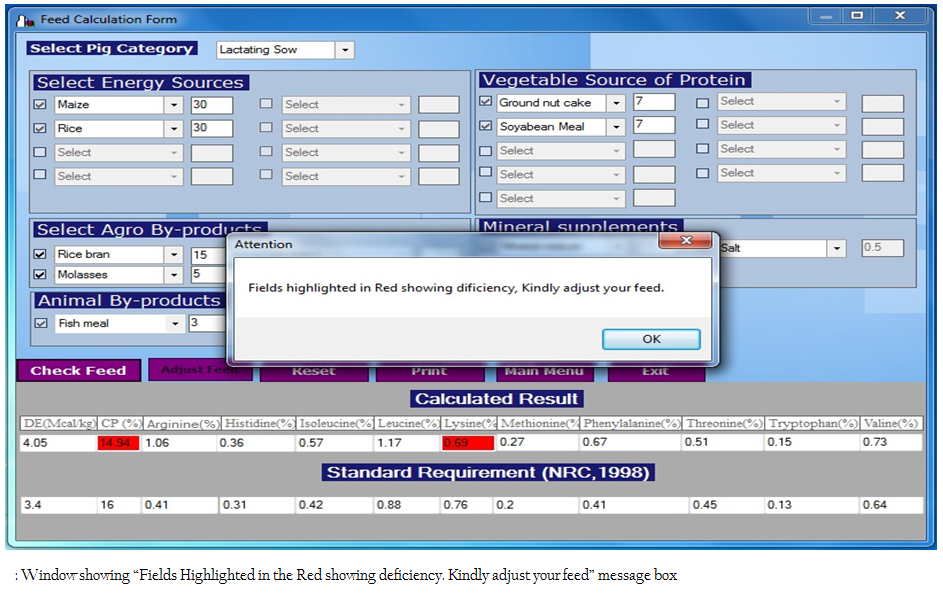
Figure 3: Window showing “Fields Highlighted in the Red showing deficiency. Kindly adjust your feed” message box
Since it contains feed ingredients available in most of the agro-ecological regions of India, it can be used in any part of the country. It can be used in Krishi vigyan Kendras (KVK), Non-Governmental organizations, state agriculture universities and other extension agencies to educate and train farmers in feed formulation. There is enough of e-readiness for ICT based technology acceptance among the pig farmers. ICT tools such as PFF can help in capacity building and open up new ways of farm management and enable efficient utilization of production factors. Hence, ICT tools can be promoted in driving the development of livestock sector.
CKNOWLEDGEMENTS
The authors thankfully acknowledge the kind support provided by Director, Indian Veterinary Research Institute, Izatnagar, to carry out this research work.
CONFLICT OF INTEREST
There is no conflict of interests among authors.
REFERENCES
Rameswar D, William T, Lapar ML, Kumar A (2007). Assam's pig sub-sector: current status, constraints and opportunities. Project Report. International Livestock Research Institute.
Dobos RC, Fulkerson WJ (2004). A database program to assist in the allocation of pasture and supplements to grazing dairy cows. Environment. Modell. Soft. 19: 581 – 589.
http://dx.doi.org/10.1016/j.envsoft.2003.08.013
Keyzer MA, Merbis MD, Pavel IFPW, van Wesenbeeck CFA (2005). Diet shifts towards meat and the effects on cereal use: can we feed the animals in 2030. Ecol. Econ. 55: 194 - 195.
http://dx.doi.org/10.1016/j.ecolecon.2004.12.002
Kumaresan A, Bujarbaruah KM, Pathak KA, Bijoy C, Das SK, Das A, Ahmed SK (2007). Performance of pigs reared under traditional tribal low input production system and chemical composition of non-conventional tropical plants used as pig feed. Lives. Sci. 107: 294 – 298.
http://dx.doi.org/10.1016/j.livsci.2006.12.007
Nath M, Elangoven AV, Mandal AB, Johari TS (2002). Manual on 'MakeFeed' software for feed formulation. Published by Head, division of Avian Nutrition and Feed Technology, Central Avian Research Institute, Izatnagar. 1 - 2.
Phand SS (2013). An information technology enabled animal health information system (AHIS): Perceptions of dairy owners. Indian J. Anim. Sci. 83 (1): 91 – 95.
Thomson E, Nolan J (2001). UNEForm: a powerful feed formulation spreadsheet suitable for teaching or on-farm formulation. Anim. Feed Sci. Technol. 91 (3 - 4): 233 - 240.
Tiwari R, Tiwari R (2001). Knowledge of livestock owners in scientific Pig farming. Indian J. Anim. Res. 35(1): 73 - 75.
Tiwari R, Sharma MC, Singh BP (2013). Development and assessment of a need based and interactive ICT based self-learning tool for livestock owners. J. Comm. Mobil. Sust. Dev. 8(1): 48 - 54.
Trostle R (2008). Global agricultural supply and demand: Factors contributing to the recent increase in food commodity prices. Economic Research Service/USDA. WRS - 0801.
Van MJ, Valancogne A, Dubois S, Dourmad JY, Seve B, Noblet J (2008). InraPorc: A model and decision support tool for the nutrition of growing pigs. Anim. Feed Sci. Technol. 143: 387 - 405.
http://dx.doi.org/10.1016/j.anifeedsci.2007.05.020
Verma MK, Pandey AK, Singh RP (2007). Knowledge Level of Tribal Pig Owners about Scientific Pig Husbandry Practices. Indian J. Anim. Res. 41 (4): 305 - 307.






